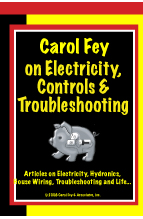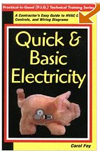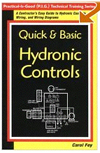by Carol Fey
Mercury bulb thermostats have been ‘mandatory equipment’ for
decades. Chances are, however, you’ll never miss them now.There’s
lots of lamenting that the age of mercury thermostats is coming
to an end. But I think it’s a positive step forward with not
much lost at all. Mercury-free models look the same on the outside
so you won’t get customer complaints. On the inside they work
even better at temperature control, and the price is about the
same.
When I was a kid, mercury was a cool thing to play with. Can
you imagine! Now mind you, this was the 1960s, when folks thought
spraying DDT promoted life and seatbelts were a Communist plot.
So in context, it’s not crazy that among my toys was my own
little jar of mercury.
Not all kids had mercury, but once they played with mine, they
wished they did! I took my mercury to school for sharing-time
only once. Everyone took the mercury out of the jar and rolled
it around in their hands. My mercury was ruined by dirt from
all those little hands. That’s OK, though, because my — ironically,
safety-freak — electrician dad got me some more.
Today there’s not much debate that mercury-on-the-loose is a
bad idea. Yet there is grumbling about the end of mercury bulb
thermostats. I want to talk about why mercury bulb thermostats
are being phased out, why they have been great, why their going
away isn’t a big loss, and how you can responsibly discard mercury
thermostats for free.
Before Electronics: First, let me explain how we got mercury
bulb thermostats in the first place, and why we hate to see
them go away. Back in the days before electronics, there was
a problem making the switch in the thermostat sensitive enough
to heat change that it could keep the temperature within just
a degree or two of set point. That couple of degrees, by the
way, is what’s known as “temperature swing.”
The heating industry standard is that for people to feel comfortable
(and we are in the comfort business) the temperature can’t vary
more than 2 degrees. That’s also known as “plus-or-minus-one-degree.”
A nonmercury bulb, nonelectronic thermostat may operate at plus
or minus 5 degrees — a temperature swing of about 10 degrees.
That might be OK in the garage, but certainly not in the living
room.
The temperature sensor in a non-electronic thermostat is a bimetal.
A bimetal is two different metals sandwiched together under
the principle that various metals expand at different rates.
The two chosen metals create a predictable movement of the bimetal
caused by change in temperature. The movement of the bimetal
causes the switch in the thermostat to close and open. The switch
closes, and the heat comes on. The switch opens, and the heat
goes off. So simple! Such a big temperature swing, because it
takes a lot of heat to get that chunk of bimetal to move!
What we needed was a metal that would move with a tiny bit of
temperature change. Now think more about the properties we need
inside the thermostat. The material needs to be metal so that
it can conduct electricity and serve to close the switch. It
would also be useful if that metal were liquid at room temperature.
Is there such a thing? You betcha — it’s mercury.
So here’s what the thermostat manufacturers did. They kept the
bimetal. But on the end of the bimetal they attached a glass
bulb containing mercury. Inside the bulb, they also put the
switch that turns the heat on and off.
The bimetal senses a degree or two of temperature drop. Because
metal contracts when it cools, it moves a bit, but not enough
to close a switch. However, its tiny movement is enough to tip
the mercury bulb, and all of the mercury flows to one end of
the tube. That’s the end where the switch is. The mercury flows
to cover both terminals of the tiny switch, and the switch is
closed. The heat comes on. When the mercury flows in the other
direction, the heat goes off.
Electronics: Why do away with a great thing? Because for about
the same money, we now can get even better temperature control
from many electronic thermostats.
Notice that I didn’t say all electronic thermostats. Temperature
control accuracy varies among manufacturers. But if you stay
with the manufacturers who made mercury bulb thermostats, you’ll
have great temperature control with their electronic thermostats,
too.
Now, what are we going to do with those millions of installed
mercury bulb thermostats as they’re replaced? Dispose of them
responsibly and for free. If you’re a contractor, take the whole
thermostat, any brand, to a thermostat distributor who’s participating
in the national recycling program. There are lots of these distributors.
You can find them on the Web at www.nema.org/trc.
Or if you’re a contractor with seven or more technicians, or
if you’re located in a rural county, you can get set up to return
on your own for a one-time fee of $15. The program picks up
all other costs, including replacement shipping containers.
There’s no paperwork and no tracking.
This recycling is done by the Thermostat Recycling Corp. TRC
was established in 1998 by three major mercury bulb thermostat
manufacturers — Honeywell, White Rodgers, and General Electric.
NEMA stands for the National Electrical Manufacturers Association.
It was founded in 1926 to provide a forum for the standardization
of electrical equipment.
There is something else lost with the passing of the mercury
bulb thermostat besides mercury. Tune in next month to find
out why that’s going to be OK, too! |




